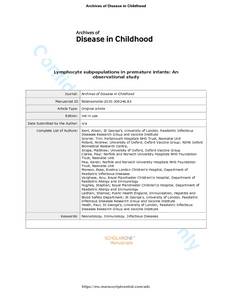Kent, A;
Scorrer, T;
Pollard, AJ;
Snape, MD;
Clarke, P;
Few, K;
Menson, E;
Varghese, AS;
Hughes, S;
Ladhani, SN;
et al.
Kent, A; Scorrer, T; Pollard, AJ; Snape, MD; Clarke, P; Few, K; Menson, E; Varghese, AS; Hughes, S; Ladhani, SN; Heath, PT
(2016)
Lymphocyte subpopulations in premature infants: An observational study.
ADC Fetal and Neonatal Edition, 101 (6).
F546-F551.
ISSN 1359-2998
https://doi.org/10.1136/archdischild-2015-309246
SGUL Authors: Heath, Paul Trafford
![[img]](https://openaccess.sgul.ac.uk/107784/1.hassmallThumbnailVersion/ADC%20submission%2011%203%2016%20%28002%29.pdf)  Preview |
|
PDF
Accepted Version
Available under License ["licenses_description_publisher" not defined].
Download (708kB)
| Preview
|
Abstract
Background and objectives The infant's immune system evolves over the first months and years of life. Strong correlation exists between lymphocyte count, lymphocyte subpopulations and gestational age at birth. Associations with antenatal and postnatal steroid treatment, infection and chronic lung disease have also been described. Few published studies report the effect of increasing postnatal age (PNA) and comorbidities on lymphocyte subpopulations in premature infants beyond the first 4 months of life. This study aimed to describe changes in lymphocyte subpopulations in preterm infants up to 13 months PNA.
Methods Premature infants (23–34 weeks completed gestation) from five centres had lymphocyte subpopulations measured at 2, 5 or 7, 12 and 13 months PNA alongside their vaccine responses in a vaccination trial.
Results 393 blood samples from 151 babies were analysed. There was an increase in absolute numbers of total lymphocytes (median cell count 6.21×109/L at 13 months compared with 4.9×109/L at 2 months PNA) and CD3+, CD4+, CD8+, natural killer and B cells with increasing age. At 2 months PNA, there was a positive correlation between gestation and CD3+ and CD4+ counts (r=0.32 and 0.46, respectively) and proportions (r=0.22 and 0.41, respectively), and CD4+:CD8+ ratios (r=0.57), but a negative correlation with CD8+ proportions (r=−0.32).
Conclusions This longitudinal study describes the distribution of lymphocyte subpopulations in premature infants and provides reference ranges for the major lymphocyte subsets to help guide clinicians when assessing premature infants for immunodeficiency in the first year of life.
Trial registration number EudraCT 2007-007535-23.
Statistics
Item downloaded times since 06 Jul 2018.
Actions (login required)
 |
Edit Item |


